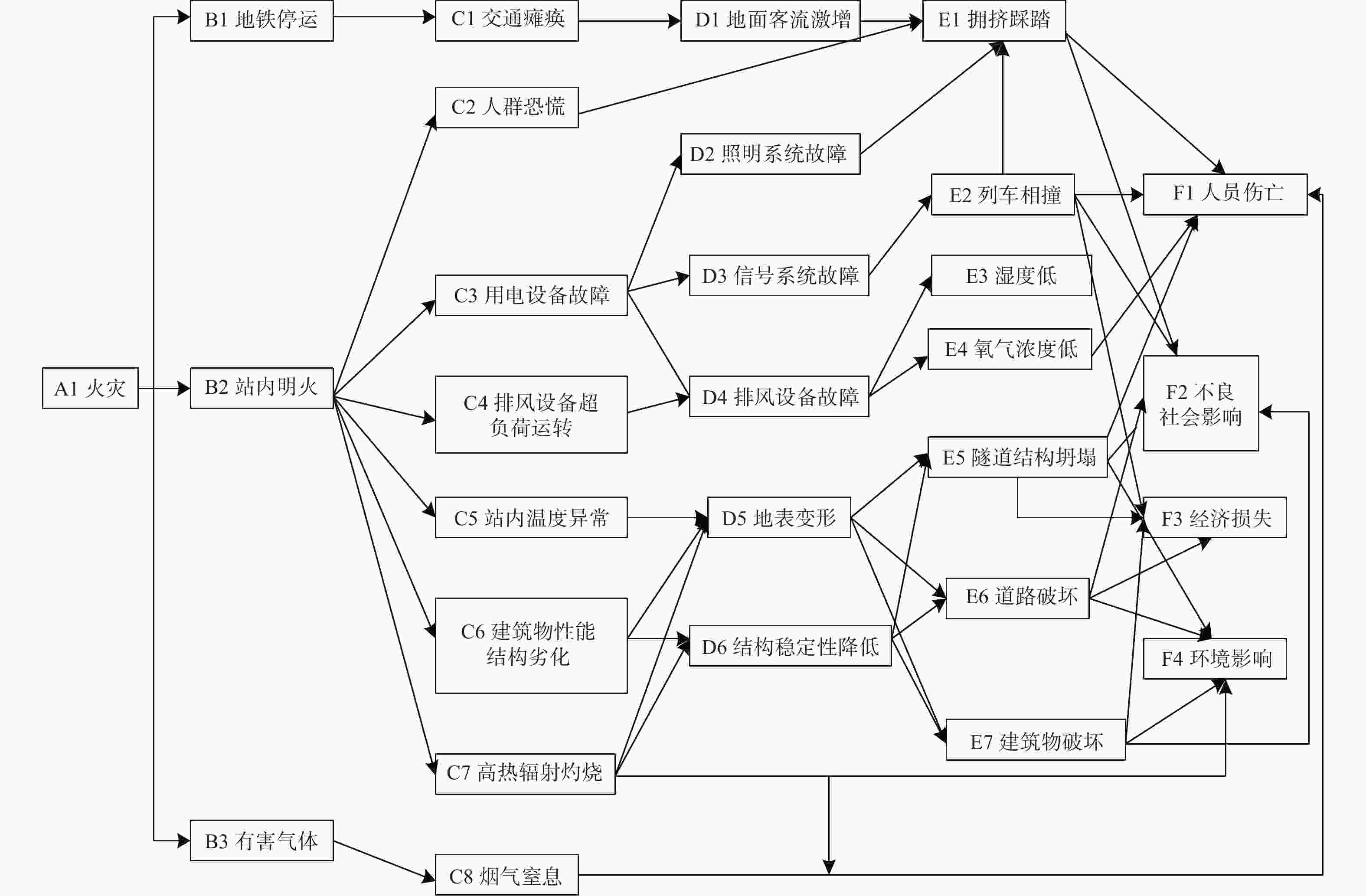Risk chain analysis of subway fire based on complex network
-
摘要:
轨道交通系统运营空间相对封闭,为保证地铁安全运营,探究风险间相互传递形成的链式效应意义重大. 基于风险链理论,对城市轨道交通火灾事件的风险因子、孕险环境、承载体特征展开研究,分析地铁火灾风险间相互传递形成的链式传导效应;建立地铁火灾风险链演化模型,采用复杂网络理论中出入度、子网节点数、中介中心性和紧密中心性4个评价指标,综合评估火灾风险网络节点重要度. 结果表明:模型中风险间传递性强,地铁车站内明火是风险控制的关键节点. 研究成果为从地铁火灾风险链角度控制风险传递,降低火灾传递过程中关键风险发生的概率提供理论支持,避免次生灾害和衍生灾害导致更严重的后果.
Abstract:The operating space of rail transit system is relatively closed. In order to ensure the safe operation of the subway, it is of great significance to explore the chain effect formed by the mutual transmission of risks. Based on the risk chain theory, the research on the risk factors, pregnancy risk environment, and carrier characteristics of urban rail transit fire events were conducted. The chain transmission effects formed by the mutual transfer of subway fire risks were analyzed. A subway fire risk chain evolution network model was established, four evaluation indicators in the complex network theory including access degree, numbers of subnet nodes, betweenness centrality and tight centrality were adopted, and the importance of fire risk network nodes was comprehensively evaluated. The results show that there is strong transmissibility between model risks, and the open fire in the subway station is the key node for risk control. The research results can provide theoretical support for controlling risk transmission from the perspective of subway fire risk chain, reduce the probability of key risks in the process of fire transmission, and avoid more serious consequences caused by secondary disasters and derivative disasters.
-
Key words:
- rail transit /
- fire /
- risk chain /
- complex network /
- risk assessment
-
表 1 地铁火灾网络节点风险分析
Table 1. Risk analysis of subway fire network nodes
风险事件 出度 入度 子网点节数 中介中心性 紧密中心性 A1 3 0 29 0.00000 0.35443 B1 1 1 6 0.00265 0.28000 B2 6 1 23 0.02844 0.45902 B3 1 1 3 0.00198 0.30435 C1 1 1 5 0.00661 0.26923 C2 1 1 4 0.00529 0.38889 C3 3 1 11 0.02345 0.39437 C4 1 1 5 0.00397 0.34146 C5 1 1 9 0.00297 0.36364 C6 2 1 10 0.00637 0.37333 C7 4 1 10 0.01100 0.44444 C8 1 1 2 0.00198 0.34146 D1 1 1 4 0.00794 0.32184 D2 1 1 4 0.00243 0.35443 D3 1 1 6 0.00656 0.34146 D4 2 2 4 0.01235 0.32558 D5 3 3 8 0.01207 0.36842 D6 3 2 8 0.01210 0.35897 E1 2 3 3 0.01698 0.43077 E2 3 1 5 0.00656 0.36842 E3 0 1 1 0.00000 0.24779 E4 1 1 2 0.00310 0.35000 E5 4 2 5 0.01229 0.40000 E6 3 2 4 0.00700 0.34146 E7 3 2 4 0.00700 0.34146 F1 0 6 1 0.00000 0.45902 F2 0 5 1 0.00000 0.38889 F3 0 4 1 0.00000 0.32184 F4 0 4 1 0.00000 0.35000 表 2 地铁火灾风险链网络节点重要度排序
Table 2. Importance ranking of subway fire risk chain network nodes
评价指标 风险事件排名前三位 出入度 站内明火、地表变形、隧道结构坍塌 子网点节数 站内明火、用电设备故障、建筑物结构性能劣化 中介中心性 站内明火、用电设备故障、隧道结构坍塌 紧密度中心性 站内明火、高热辐射灼烧、拥挤踩踏 -
[1] 朱奥妮. 2000—2019年国内外地铁火灾事故统计分析[J] . 城市轨道交通研究,2020,23(8):148 − 150. [2] FRANTZICH H K. Risk analysis and fire safety engineering[J] . Fire Safety Journal,1998,31(4):313 − 329. doi: 10.1016/S0379-7112(98)00021-6 [3] ROH J S, RYOU H S, PARK W H, et al. CFD simulation and assessment of life safety in a subway train fire[J] . Tunnelling and Underground Space Technology,2009,24(4):447 − 453. [4] BENKOUSSAS B, BOUHDJAR A, VAUQUELIN O. Numerical security assessment in case of fire in underground transport spaces[J] . Nature & Technologie,2015,14(12):45 − 59. [5] 卢亿. 地铁火灾的事故树分析[J] . 城市轨道交通研究,2011,14(2):95 − 97,102. doi: 10.3969/j.issn.1007-869X.2011.02.021 [6] 陈曼英, 高轩能, 刘忠. 地铁车站火灾风险的模糊综合评价[J] . 数学的实践与认识,2011,41(23):72 − 77. [7] 侯昱晟, 李炎锋, 石勃伟, 等. 地铁换乘车站的火灾风险评估[J] . 消防科学与技术,2014,33(11):1326 − 1329. doi: 10.3969/j.issn.1009-0029.2014.11.029 [8] 刘顶立, 徐志胜, 王飞跃. 基于后果概率估计的地铁集群火灾风险评估[J] . 铁道科学与工程学报,2021,18(3):813 − 820. [9] 王艳辉, 晋君, 李曼. 基于三角模糊因果图的城市轨道火灾事故分析[J] . 中国安全科学学报,2013,23(11):22 − 26. doi: 10.3969/j.issn.1003-3033.2013.11.004 [10] 李藐, 陈建国, 陈涛, 等. 突发事件的事件链概率模型[J] . 清华大学学报(自然科学版),2010, 50(8):1173 − 1177. [11] 李继清, 张玉山, 王丽萍, 等. 洪灾综合风险结构与综合评价方法(Ⅰ): 宏观方面[J] . 武汉大学学报(工学版),2005,38(5):19 − 23. [12] 徐高峰. 韩国大邱地铁火灾的启示[J] . 浙江消防,2003(4):17 − 19. [13] 袁勇, 邱俊男. 地铁火灾的原因与统计分析[J] . 城市轨道交通研究,2014,17(7):26 − 31. [14] 王敏, 代宝乾, 张岚, 等. 国内外典型地铁火灾事故案例分析及预防措施[J] . 安全,2015(6):34 − 37. doi: 10.3969/j.issn.1002-3631.2015.06.010 [15] 王林, 张婧婧. 复杂网络的中心化[J] . 复杂系统与复杂性科学,2006,3(1):13 − 20. [16] 胡一竑. 基于复杂网络的交通网络复杂性研究[D]. 上海: 复旦大学, 2008. [17] 喻依. 复杂网络节点重要性研究[D]. 广州: 暨南大学, 2015. -






 下载:
下载:








